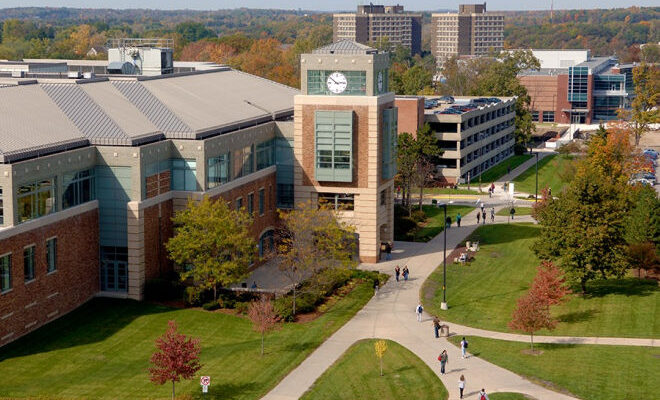
The Future of Equality
A Pipeline for Future Equity
By Ryann Brooks
Jay Sloan (they/them) didn’t really know what they wanted to do when they went to college. While they had applied to some schools and knew they would have some success, they hadn’t felt truly accepted or welcome anywhere and didn’t have a top choice.
And then Eastern Michigan University came to visit their Grand Rapids, Mich. high school.
“I was like, ‘this is the school that I have to go to,’” they said. “I was like, ‘This is the school I need to be at.’ There was this very strong pull to be there. I felt like Eastern ticked all those boxes.”
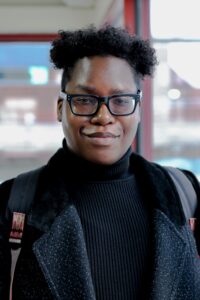
Jay Sloan | Courtesy Photo
Eastern Michigan University touts itself as one of the most diverse public universities in Michigan and boasts the highest percentage of Black and Hispanic students. The commitment to diversity has been built over the course of decades as the university recognized the success of its students hinged on “a diverse, equitable learning and teaching platform.”
A queer Black person of color longing for a space that felt welcoming and safe, Sloan said the university’s commitment to diversity, equity and inclusion seemed to extend beyond what many higher education institutions offer.
“Eastern was listed in a lot of different places as being a campus [that was] really safe for queer people and a campus that was dedicated to making space specifically for queer people,” Sloan said. “That was a huge choice — is a huge choice — in my decision-making, and I think it is for most queer students in high school. There are many high schoolers who are just craving a space where they feel supported and comforted and affirmed and welcome.”
For queer students at Eastern Michigan University, that space is the LGBT Resource Center.
Designed as a safe haven to cultivate support and offer resources to both on- and off-campus students, the Center is the place where LGBTQ folks know they belong. Students can apply for scholarships, receive assistance in updating their records with a preferred name, find LGBTQ-inclusive housing and find a number of programs and support groups.
“I think one of the biggest pieces around diversity and belonging and inclusion at college campuses that our center works towards is that queerness and transness, they’re not identities that you can look at somebody and know,” said Amy Finkenbine (she/they), LGBT Resource Center coordinator. “A lot of students on campus who belong to intersectional identities, you can look around and see, ‘Do I look like I belong in this room or not?’ And so our students sometimes struggle to meet other LGBTQ folks.”
The Center is ever-evolving and always receptive to student needs, including how the needs of the BlPOC trans community may vary from those of other trans communities.

Amy Finkenbine | Courtesy Photo
“We try to center other identities and put them at the forefront,” Finkenbine said. “So we have our trans/non-binary/questioning support group, or TNQ. We have our asexual/aromantic support group. We have our queer and trans people of color collective. These are all really student-run and student-led, because students are the experts of their experience. We try to center their voices in those spaces.”
Located in Ypsilanti, Mich., between Ann Arbor and Detroit, Eastern Michigan University has an enrollment of about 16,000 undergraduate and graduate students. Founded as a teacher’s college in 1849, the institution has a long history of embracing diversity. But by the dawn of the 21st century, the state university was struggling, as were many public and private higher education institutions across the country. When Dr. James Smith accepted the position of university president in 2016, he undertook a turnaround plan to bring the institution into fiscal viability. Within two years, the university regained financial stability, and, working with stakeholders across campus, Smith developed an updated strategic plan.
The updated plan focuses on promoting student success and engagement, providing high-quality academic programs and quality research and engaging and serving Eastern Michigan University and the surrounding communities. When introducing the current strategic plan to the campus community in 2019, Smith said, “An important overarching institutional commitment to diversity, equity and inclusion will be woven into all of these priorities.”
In speaking with BEQ Pride, Smith said the university’s commitment to creating a diverse community gives students a “broader range of perspectives” which introduces them to “new and different ways of thinking.”
“We take great pride in creating what we describe as a global classroom — preparing students for the global world they will live and work in where they will be side-by-side with people from different cultures, backgrounds and identities,” he said.
Smith said focusing on diversity and actively recruiting diverse student bodies is essential to understanding those different perspectives and challenges.
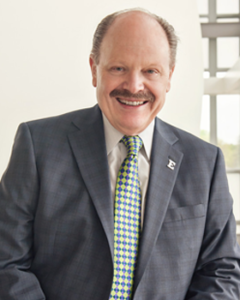
Dr. James Smith | Courtesy Photo
“How would we build solutions to problems a homogenous population might never consider or certainly never truly understand?” he said. “The return on investment is truly based on belongingness. If students find comfort on campus and feel they genuinely belong here, they make us a stronger institution. They share this with their friends, which attracts new students. We retain them because they remain active and engaged with the University through graduation. They may move into graduate programs. And, they become successful alumni who want to stay involved and give back.”
Sloan is one of those students who chose to remain on campus and earn an advanced degree, with plans for a career in social work. Their time at Eastern Michigan University — and the LGBT Resource Center — has been a chance for them to finally be their authentic self, a story that Sloan says is not unique.
“I think in transitioning onto campus and living on campus, that was an opportunity for me to be authentic in my lived experience and start to really find out more about myself and learn more about the world that I’m in,” they said. “I have a very religious background, I have a very sheltered background. My parents are very protective and I knew for a long time that I held a lot of identities that I didn’t see around me. I wasn’t supported at all. Eastern really delivered on its promise to be that space where I could refine that part of myself and polish it and it’s still proving to be that place.”
Eastern Michigan University has multiple success stories they credit to prioritizing DEI across all departments, programs and goals. Initiatives like the Early College Alliance (ECA) aim to create opportunities for students from underserved communities to attend and graduate from university. The matriculation rates for Black students are impressive — college graduation rates at Eastern Michigan University among Black students in the program are 700% higher when compared to Black high school graduates across Michigan.
“As students enter the ECA program from over 50 prior educational settings, we know that we need to teach them more than academics,” said ECA Principal Dr. Ellen Fischer. An out lesbian who built intersectionality into the program, Fischer believes integrating DEI into every aspect of Eastern is crucial to prepare students for the future. “An understanding of what it means to interact in a diverse setting is part of the life skills that are important for success in college and eventually in the world of work. So, for example, we hold a seminar for all first-year students in their first semester in which we teach students explicitly about diversity— including exploring social identities and definitions of various identities, discussions with Eastern and other community experts on topics related to diversity, and opportunities to discuss these things in groups with one another. For example, many of our students may never have had to introduce him/her/themself with their pronouns before, and we think it is important to explain what that’s all about and why this is important.”
As a new academic year begins, Eastern Michigan UniversityEastern is in a strong position under Smith’s leadership. With his unceasing commitment to creating a place where students, faculty and staff all feel welcome as their authentic selves, Smith is looking forward to another year of opportunity.
“When we build real-life experiences into the work we do, in and outside the classroom, the possibilities are limitless,” he said. “At Eastern Michigan University, we are engaged with the community in myriad ways. Our students see the theoretical and live the practical. The University has at its core a mission as a university of opportunity. We break, quite often, the glass ceiling and other barriers to success, which allows these experiences to come together in rather fabulous ways.”
Learn more about Eastern Michigan University at emich.edu.
Success Story: Sam D’Arcy-Darling
Sam D’Arcy-Darling (he/they) graduated from Eastern Michigan University in 2018 with a Bachelor’s degree in Political Science. As an undergraduate, he served as a Senator in Eastern Michigan University’s student government, consulted with the Michigan Department of Education on various projects regarding students with minority/marginalized identities and served as a Human Relations Commissioner for the city of Ypsilanti, Mich. In 2019, he moved to the United Kingdom where he is earning a Master’s degree in politics at the University of London and serves as a government relations officer with Transport of London.

Sam D’Arcy-Darling | Courtesy Photo
Every time I look at my bachelor’s degree on the wall it brings back memories of the experiences and opportunities that were given to me at Eastern Michigan University. When I spoke out about an issue or concern I felt like my voice was heard by faculty, staff and administration. I could go to my professors and tell them I had a rough day and they’d provide advice and feedback, sometimes extending deadlines with no further questions asked.
I also found that faculty in particular had an internal radar for how external events impacted students. The administration tried every day to learn from its mistakes and take criticism, forming it into a constructive solution. They did this after [a 2016 incident involving] racist vandalism by completely restructuring the student conduct process to focus on restorative rather than punitive justice. This ensured that learning was at the front of any behavioral or academic honesty issue. It also took aim at the punitive justice disparity between white students and students of color.
From the self-development end, I remember being told during new student orientation that “you’ll leave a different person than the one who arrived.” That was incredibly true for me. I arrived very firm in my identity as a queer person but struggled to intersect my racial entity as a bi-racial individual with my queerness. The spaces the university opened for my identities through the LGBT Resource Center and the Center of Race and Ethnicity gave me access to people and information which over time enabled me to affirm my intersecting identities.
I could not be happier with my time at Eastern. I remember on September 4, 2015, when I moved in being worried about what I was doing and even wanting to leave, but the community puts its arms around you. Everyone from Eastern President Smith to office administrative staff cares profoundly about you.
I wouldn’t be stepping into my role with one of the world’s largest public transportation authorities, Transport for London, without the skills and experiences I gained at Eastern. I’m not only a first-generation college graduate, but with the encouragement of my entire academic department, I went on to pursue a Master’s degree overseas. As an alumnus, I still have frequent conversations with Eastern’s faculty and staff, some of whom I consider to be personal friends along with many former peers who are now life-long friends.
A university can talk about diversity and inclusion, but until it puts actions behind its words, the words mean nothing. Eastern takes the inclusion to heart and each day in my experience the institution is asking itself “How can I do better now and also tomorrow?” The lasting impact of my time at Eastern was life-altering in ways I had only dreamed of.
 Ryann Brooks (she/her) is an award-winning journalist and editor for a small town Kansas newspaper. Ryann actively uses her position at her day job to advocate for the LGBTQ community through op-eds and editorials and is fond of telling detractors that she’s done her research. When she isn’t working, she enjoys taking adventures with her two children and her husband, running and reading a good book. Follow her on Instagram and Twitter.
Ryann Brooks (she/her) is an award-winning journalist and editor for a small town Kansas newspaper. Ryann actively uses her position at her day job to advocate for the LGBTQ community through op-eds and editorials and is fond of telling detractors that she’s done her research. When she isn’t working, she enjoys taking adventures with her two children and her husband, running and reading a good book. Follow her on Instagram and Twitter.
Business Equality Pride (BEQPride) is the first publication from the BEQ family of national print and digital magazines exclusively addressing the needs of LGBTQ small-to-medium sized businesses, entrepreneurs and professionals.





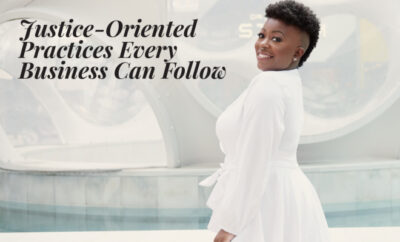



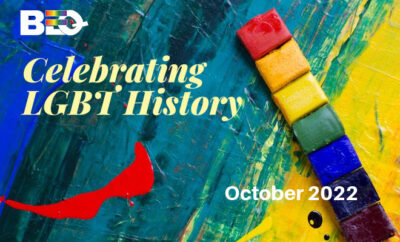







0 comments